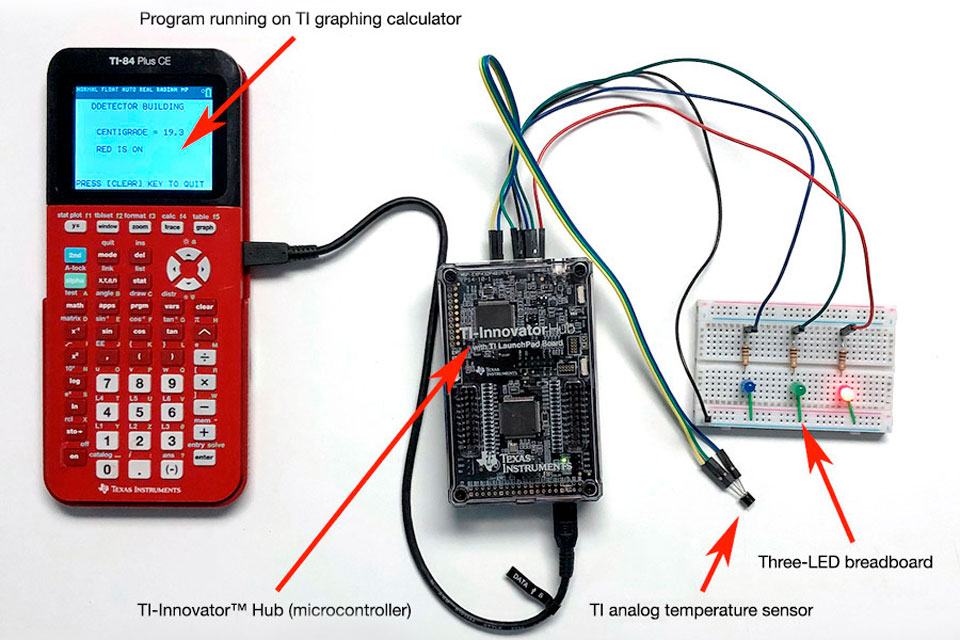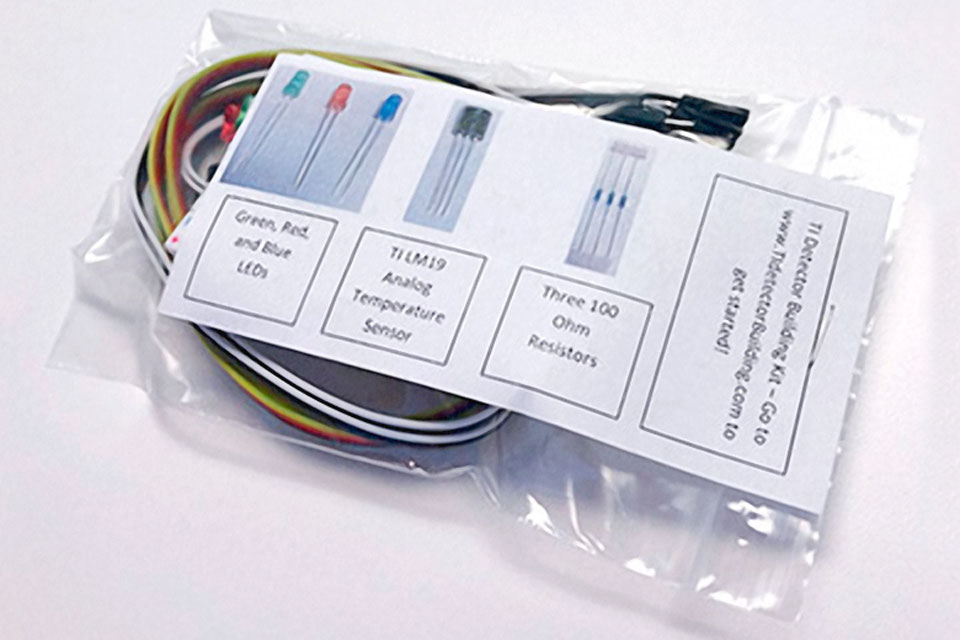Let TI Help You With the New Science Olympiad Detector Building Event

Science Olympiad, a national science/STEM competition organization, just added a new high school event called Detector Building. In the 35-year history of Science Olympiad, incorporating coding has been challenging because of inequitable computer availability and a lack of training resources for teachers and students.
In the last few years, Texas Instruments (TI) has helped to close the gap. Most schools in the country have TI graphing calculators with coding capability. TI also developed the popular TI Codes program which includes 10 Minutes of Code with TI-Innovator™ Hub, a free online training resource for non-coders, where students and teachers develop coding skills using a TI graphing calculator.
Realizing that a coding event may be possible because of the resources that TI and others have made available to the general public in recent years, Science Olympiad leadership worked with teachers and industry partners to develop the Detector Building event. This new event requires teams to build a working waterproof temperature sensor, code it, calibrate it and test it. The event requires an integration of science, technology, engineering and mathematics, making it a true STEM project!
Looking at each of the letters of the STEM acronym in more detail, it becomes obvious that students who participate in this project will get a much deeper understanding of how sensors actually work.

The SCIENCE behind this project is all about measurement and circuits. Students will need to calibrate their sensor against a known digital thermometer. Therefore, students will need to understand science concepts such as accuracy and precision. In addition, they will learn how circuits work as they build their sensor using a breadboard, wires, resistors and an analog temperature sensor or thermistor.
The TECHNOLOGY portion of STEM is obvious since they are actually using technology to build technology. They are making a working temperature probe. They will use a microcontroller device, like the TI-Innovator Hub™ with TI LaunchPad™ Board, a breadboard and components, as well as a graphing calculator or computer to write the code that makes it all work.
The ENGINEERING aspect is the requirement to build the sensor using the aforementioned parts and pieces. In addition, they have to test their sensor, fix bugs, adjust design and test again … and again … and again until they get it working properly. They also must find a way to waterproof their sensor using a material that won’t completely insulate the temperature-sensing portion of the probe, but can hold up against temperature extremes.
Finally, the MATH comes in during the calibration phase. Students will need to calibrate their homemade sensor against a store-purchased digital thermometer. That means they’ll need to develop a linear or non-linear mathematical model using a calibration equation. That equation will be developed using known temperatures at various levels. The equation will then be added to their temperature sensor’s code.

To make this process of learning to build, code, calibrate and test their sensor, TI has developed a free website, www.TIdetectorBuilding.com. There, students can watch a video that provides hints and references to useful resources such as TI’s Path to STEM Projects to learn the engineering and coding skills they’ll need to be successful in the construction of the sensor. If students are still stuck, they’ll have access to the TI STEM Team at STEM-Team@ti.com for help in the use of TI technology.
In addition to providing schools with resources for Science Olympiad, TI can also help with all things STEM. Go to www.TIstemProjects.com to see what is available.
About the author: Erick Archer is a product strategy manager at Texas Instruments in the education technology division. He is a former high school science teacher and now works in a team that develops activities and projects for students.
Tagcloud
Archive
- 2025
- 2024
- 2023
- 2022
-
2021
- January (2)
- February (3)
- March (5)
-
April (7)
- Top Tips for Tackling the SAT® with the TI-84 Plus CE
- Monday Night Calculus With Steve Kokoska and Tom Dick
- Which TI Calculator for the SAT® and Why?
- Top Tips From a Math Teacher for Taking the Online AP® Exam
- Celebrate National Robotics Week With Supervised Teardowns
- How To Use the TI-84 Plus Family of Graphing Calculators To Succeed on the ACT®
- AP® Statistics: 6 Math Functions You Must Know for the TI-84 Plus
- May (1)
- June (3)
- July (2)
- August (5)
- September (2)
-
October (4)
- Transformation Graphing — the Families of Functions Modular Video Series to the Rescue!
- Top 3 Halloween-Themed Classroom Activities
- In Honor of National Chemistry Week, 5 “Organic” Ways to Incorporate TI Technology Into Chemistry Class
- 5 Spook-tacular Ways to Bring the Halloween “Spirits” Into Your Classroom
- November (4)
- December (1)
-
2020
- January (2)
- February (1)
- March (3)
- April (1)
- May (2)
- July (1)
- August (2)
- September (3)
-
October (7)
- Tips for Teachers in the time of COVID-19
- Top 10 Features of TI-84 Plus for Taking the ACT®
- TI Codes Contest Winners Revealed
- Best of Chemistry Activities for the Fall Semester
- Best of Biology Activities for the Fall Semester
- Best of Physics Activities for the Fall Semester
- Best of Middle Grades Science Activities
- November (1)
- December (2)
- 2019
-
2018
- January (1)
- February (5)
- March (4)
- April (5)
- May (4)
- June (4)
- July (4)
- August (4)
- September (5)
-
October (9)
- Art in Chemistry
- Which Texas Instruments (TI) Calculator for the ACT® and Why?
- Meet TI Teacher of the Month: Jessica Kohout
- Innovation in Biology
- Learning With Your Students
- A first-of-its-kind STEM strategy charts path to help educators
- #NCTMregionals Hartford 2018 Recap
- The Math Behind “Going Viral”
- Real-World Applications of Chemistry
-
November (8)
- Testing Tips: Using Calculators on Class Assessments
- Girls in STEM: A Personal Perspective
- 5 Teachers You Should Be Following on Instagram Right Now
- Meet TI Teacher of the Month: Katie England
- End-of-Marking Period Feedback Is a Two-Way Street
- #NCTMregionals Kansas City 2018 Recap
- Slope: It Shouldn’t Just Be a Formula
- Hit a high note exploring the math behind music
- December (5)
- 2017
- 2016
- 2015
